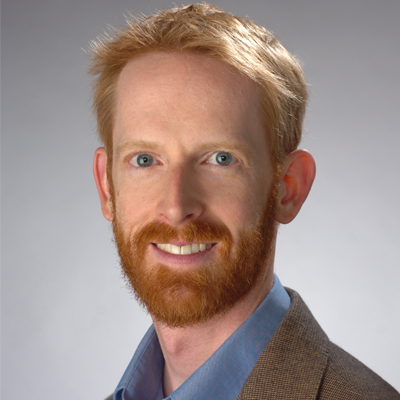Polymers with shape-changing programmability for tissue engineering and regenerative medicine
Orthopedic injuries are a common cause of disabilities for soldiers, veterans, and civilians; and such injuries are extremely difficult and costly to treat. Regardless of the cause -- whether by trauma or congenital deformity from birth -- orthopedic disabilities induce substantial discomfort and loss of functionality, and advanced treatments are critical for improving patients’ quality of life. Dr. James Henderson, Associate Professor of Biomedical and Chemical Engineering at Syracuse University, brings shape-memory polymers in vitro and in vivo to study mechanobiology and to develop new strategies for tissue engineering and regenerative medicine, with the goal of increasing the speed with which these injuries can be treated. Through novel methods of grafting and stabilizing complex fractures with these unique biomaterials, Dr. Henderson hopes to help people achieve a higher level of function more rapidly as they return to normal activity and to reduce pain, inconvenience, and cost.
Shape-memory polymers (SMP) have the ability to ‘‘memorize’’ a permanent shape, which can then be heated, elastically deformed, cooled and “fixed” into a temporary shape though an immobilizing transition and then later recover to the permanent shape through a triggering event, like heating or hydration. Dr. Henderson’s interdisciplinary team and collaborators focus on understanding the mechanobiology of tissue development, maintenance, and disease progression, and exploiting the SMP technology to incorporate this understanding in tissue-engineering and regenerative medicine approaches. His work, therefore, has the potential to lead to improvements in clinical practice that may achieve faster outcomes with fewer surgeries, less pain and risk to the patient, more rapid resumption of activity, and improved quality of life, thereby positively impacting a significant proportion of civilians, military service members, and veterans.
Current research includes:
- Stabilizing Biodegradable Self-Tightening Internal Casts: Support, or stabilization, is required for a complex fracture to heal, and currently the most common methods of support are metal plates, rods, and screws that are implanted internally to hold the bones in place or external pins penetrating the skin to connect to and stabilize the underlying bone fragments. Complications of these methods can include: additional loss of bone as the metal hardware bears too much of the load; multiple surgeries to remove or replace the metal hardware; and difficult-to-cure infections on or around the impact materials. To this end, Dr. Henderson leverages the programmable capabilities of SMPs to conform to the fracture for more effective stabilization, creating “smart sleeves” that can serve as an alternative option for surgeons. These experiments were performed in mice, and Dr. Henderson hopes to now test them in more clinically relevant model of complex fractures for clinical use.
- Medically Motivated Synthetic Grafts: In segmental defects, a graft must be used to fill the bone gap in addition to stabilizing the fracture. A piece of bone from the same patient is the best graft option currently available, but there is seldom enough “extra” bone elsewhere in the body. As a result, doctors must frequently resort to grafts from cadavers, which often fracture after use, carry risk of infection and disease transmission, and are expensive. Dr. Henderson is thus developing the “smart graft” made from shape-memory polymers, designed to expand and anchor itself against the remaining intact bone at the edges of a segmental defect.
- Mechanobiology Platform Development: Mechanobiology is the study of how biomechanical stimuli—such as extracellular stresses, strains, matrix architecture, or stiffness—contribute to development, disease, and healing. In order to understand mechanobiology, it is critical to study how cells respond when their biomechanical environment changes over time. To answer fundamental questions about mechanobiological events during development, disease, and healing, Dr. Henderson has begun to create two-dimensional and three-dimensional biomaterial platforms to probe the process, and is developing analytical tools that will be necessary to fully employ these new biomaterial platforms.
- Other Applications Outside Fracture: During mechanobiological events, cells experience a change in the architecture and the shape of their environment that affects their behavior. Some of the 3D SMP platforms are used for in vitro models of tissue development in diseases such as cancer, which can particularly be used to study how breast cancer cells associated with pregnancy respond to changes in their local architecture as the fiber stretcher in the breast changes over time. Other applications include collagen fiber orientation during wound healing in skin.

Bio
Dr. James Henderson, Ph.D., is an Associate Professor of Biomedical and Chemical Engineering and the Bioengineering Graduate Program Director at Syracuse University. His training in Mechanical Engineering was completed at Rice University (B.S.) and at Stanford University (M.S., Ph.D.), where he was a dual Hertz Foundation/Burt and Deedee McMurtry Stanford Graduate Fellow. He pursued his postdoctoral training in the departments of Biology and Orthopaedics at Case Western Reserve University as an Arthritis Foundation Postdoctoral Fellowship. Having joined the faculty of Syracuse University in 2008, Dr. Henderson’s lab focuses on the study and application of mechanobiology. Dr. Henderson is a faculty member of the Syracuse Biomaterials Institute and of the SUNY Upstate Medical University Cancer Research Institute and holds an adjunct position in the Syracuse University department of Biology. He received the Aspiring Investigator Award at the 5th Annual Meeting of the Midwestern Tissue Engineering Consortium in 2005, the New Investigator Recognition Award at the Combined Meeting of the Orthopaedic Research Societies in 2007, the LC Smith College of Engineering and Computer Science Faculty Excellence Award in 2010, and the DARPA Young Faculty Award in the class of 2012.
As an engineering student, Dr. Henderson loved being able to use a few equations to understand so much about how the world works. But it was combining biology--with its complexity and potential to improve human lives--with mechanical engineering that led him to a career in bioengineering research. He hopes that his research will improve understanding of how our bodies work, to enable new regenerative medicine strategies for better human health and well being.
Outside of research, Dr. Henderson enjoys backpacking, camping, hiking, and cycling.
For more information, visit henderson.syr.edu
In the News
Publications
Videos
Awards
Defense Advanced Research Projects Agency (DARPA) Young Faculty Award, 2012
College of Engineering and Computer Science Faculty Excellence Award, 2010
New Investigator Recognition Award (NIRA), 2007
6th Combined Meeting of the Orthopedic Research Societies
Arthritis Foundation Postdoctoral Fellow, 2006-2008
Aspiring Investigator Award, 2005
5th Annual Meeting of the Midwestern Tissue Engineering Consortium
Dual Hertz Foundation Fellow/Stanford Graduate Fellow, 1999-2004
Burt and Deedee McMurtry Fellow


